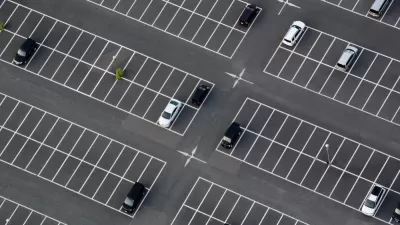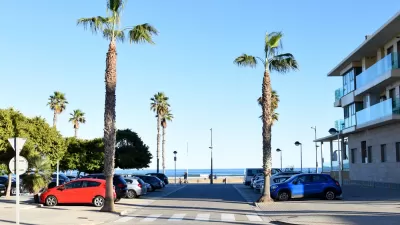More cities and states are recognizing the harmful impacts of minimum parking requirements, which in many cases have accelerated sprawl and raised the cost of housing construction.

California’s recent decision to eliminate parking requirements at developments near public transit could have a major impact on the country’s parking lot ‘addiction,’ writes Ciara Nugent in Time. “The move will encourage developers to build more affordable homes for people who don’t want a parking space, and generate ‘more walkable neighborhoods and public transit,’ [California Governor] Newsom said.”
According to Nugent, “The shift is heartening for climate advocates who believe redesigning cities and how people move around them must be a critical part of the country’s efforts to reduce its outsize greenhouse gas emissions from cars.” The law doesn’t bar developers from building as much parking as demand calls for, but prevents cities from maintaining often exaggerated requirements that drive up building costs.
The article details the history of minimum parking requirements, which began as a reaction to the sudden influx of automobiles to cities as the invention became more affordable. “As more people bought cars, a self-fulfilling cycle set in: cities started to separate districts by use, assuming everyone can drive from their residential area to their shopping area to their office. Large highways began to cut through town centers, making it harder to cycle or walk.”
Today, the tide is slowly turning against parking as cities and states eliminate parking minimums, invest in public transit and other multimodal infrastructure, and encourage developers to build denser, more transit-oriented development that reduces the American overreliance on cars.
FULL STORY: Americans' Addiction to Parking Lots Is Bad for the Climate. California Wants to End It

Trump Administration Could Effectively End Housing Voucher Program
Federal officials are eyeing major cuts to the Section 8 program that helps millions of low-income households pay rent.

Planetizen Federal Action Tracker
A weekly monitor of how Trump’s orders and actions are impacting planners and planning in America.

Ken Jennings Launches Transit Web Series
The Jeopardy champ wants you to ride public transit.

Opinion: Transit Agencies Must View Service Cuts as Last Resort
Reducing service could cripple transit systems by pushing more riders to consider car ownership, making future recovery even less certain.

‘Smart Surfaces’ Policy Guide Offers Advice for Building and Maintaining Urban Tree Canopies
Healthy, robust tree canopies can reduce the impacts of extreme heat and improve air quality.

New Jersey Lawsuit Targets Rent-Setting Algorithms
The state of New Jersey is taking legal action against landlords and companies that engage in what the state’s Attorney General alleges is illegal rent fixing.
Urban Design for Planners 1: Software Tools
This six-course series explores essential urban design concepts using open source software and equips planners with the tools they need to participate fully in the urban design process.
Planning for Universal Design
Learn the tools for implementing Universal Design in planning regulations.
Heyer Gruel & Associates PA
Ada County Highway District
Institute for Housing and Urban Development Studies (IHS)
City of Grandview
Harvard GSD Executive Education
Toledo-Lucas County Plan Commissions
Salt Lake City
NYU Wagner Graduate School of Public Service





























